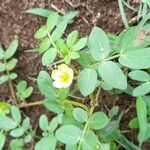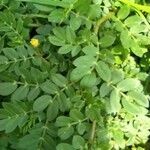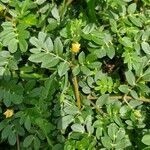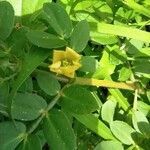Herbs, annual. Stems prostrate to decumbent, to 1(–1.5) m, sericeous and sparingly hirsute with white or yellow antrorse hairs, becoming glabrate. Leaves obovate in outline, 1–6 × 1.5–5 cm; stipules 3–5 × 1 mm; leaflets 6–8(–12), broadly oblong to elliptic, 5–29 × 3–14 mm, terminal pair usually largest, surfaces appressed-hirsute to glabrate, veins and margins sericeous. Pedicels 10–50 mm in flower and fruit, at first shorter than subtending leaves, equaling them or longer in fruit, little thickened distally, straight or curved. Flowers 7–25 mm diam.; sepals persistent, ovate, 3–8 × 2–3 mm, as long as or little shorter than petals, in flower as long as style, in fruit clasping but not entirely covering mature fruit body and shorter than beak, only scarious margins becoming involute, hirsute; petals marcescent, usually ± 2-colored, basally usually white to yellow-green or green, rarely red (often brighter than distal portion), fading white to bright orange, distally white to yellow or pale orange, obovate, 5–12 × 4–10 mm; stamens as long as style; anthers yellow or red-orange, usually ovoid, rarely linear, 1 mm; ovary ovoid, 1 mm, usually glabrous, sometimes strigose at base, rarely to base of style; style cylindric but slightly conic basally, 2–3 mm, 2–3 times as long as ovary, glabrous; stigma terminal. Schizocarps ovoid, 5–6 mm diam., usually glabrous, sometimes strigose at base or rarely to base of beak; beak cylindric, 3–7 mm, usually as long as fruit body, base widely conic, glabrous; mericarps 3–4 × 1 mm, abaxially tuberculate, cross-ridged, or slightly keeled, tubercles if present all rounded, less than 1 mm, sides pitted, adaxial edge angled.
More
Annual herb; stems prostrate to decumbent, to 1 m long, sericeous and spar-ingly hirsute with apically-directed white trichomes. Leaves obovate, 1-5.5 cm long, 1-3.5 cm wide; leaflets 3-4 pairs, broadly oblong to elliptical, appressed-hirsute to glabrate, margins and veins sericeous, 5-18 mm long, 3-11 mm wide, terminal pair usually largest. Flowers ca 1 cm in diam; peduncles to 28 mm long; sepals ovate, 4-5 mm long, 2 mm wide, as long as or little shorter than petals, hirsute with appressed to spreading trichomes, in flower ca as long as style, in fruit clasping but not entirely covering mature mericarps and shorter than beak, only scarious margins becoming involute, persistent; petals yellow, fading orange, obovate, 4-6 mm long, to 6 mm wide, marcescent;-ovary ovoid, ca 1 mm in diam, usually glabrous but occasionally strigose basally, the style 2 mm long, cylindrical, base slightly conical, the stigma capitate, ca 1 mm long, obscurely 1 0-lobed, papillose. Fruit ovoid, 4-5 mm in diam, usually glabrous but occasionally strigose basally, the beak 3-6 mm long, glabrous, cylindrical, the base widely conical; mericarps 4 mm high, 1.5 mm wide, abaxially tubercled, cross-ridged, and slightly keeled, sides pitted, adaxial edge angled.
Moist thickets or plains, often in sand or a weed in cultivated ground, mainly near sea level, but also extending to elevations of 1,500 metres.






